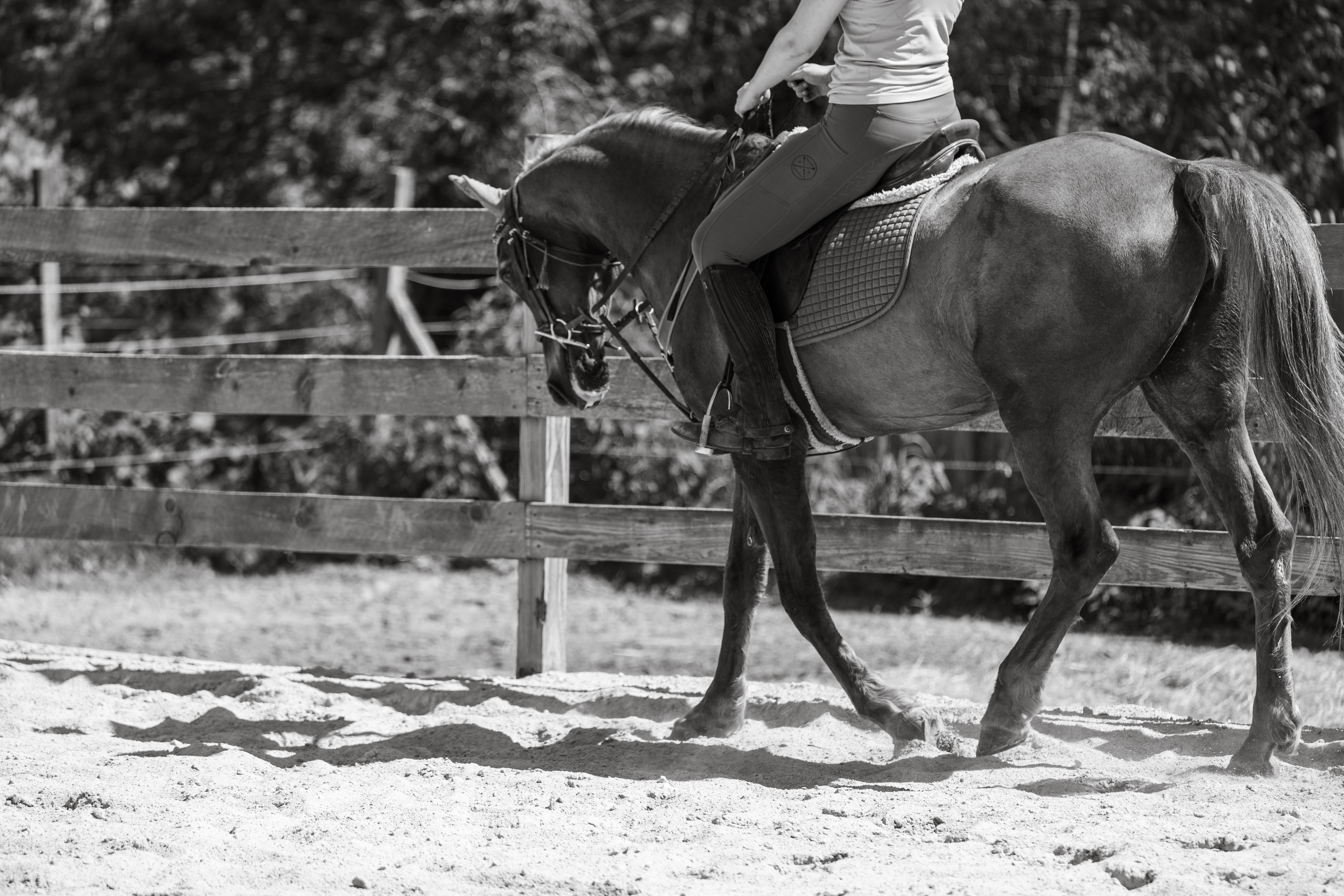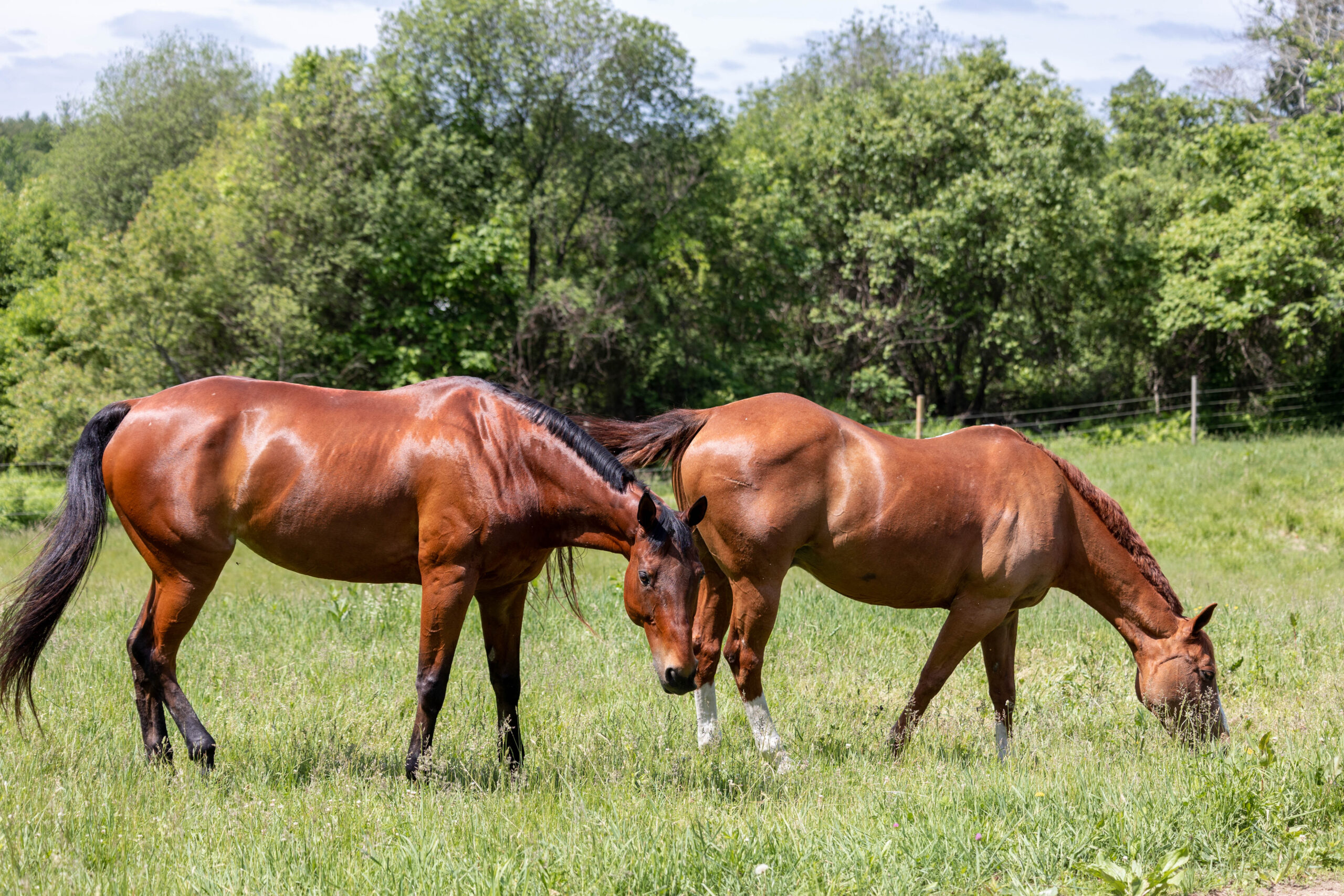Most horse care and safety articles, instructors and videos will tell you, you should never walk or stand behind a horse. And, most of the time, they’re correct. Especially if you’re a beginner equestrian and haven’t worked around horses yet. Inevitably, there will come a time when you need to walk behind or work around the hind-end of a horse. And so, in this article we’ll talk about how to do so safely.
Why You Should Not Stand Behind A Horse
Let’s start with the basics, even if you’ve heard it a million times you might be wondering, why shouldn’t you walk behind a horse? The short answer is, you could get kicked. Here’s why:
Horses are prey animals meaning they are hunted by predators and typically have a flight response vs a fight response. You can tell a horse is a prey animal by the placement of their eyes on the side of their heads. This allows a horse to see danger coming from behind and the opportunity to run if needed. For this reason, walking behind a horse especially a young or green horse without much training could scare them.
If a horse becomes scared and cannot run away, they will defend themselves instead. This could mean a kick or bite.
Horses also kick out to defend themselves against or show aggression towards other horses. Standing near the hind end of a horse within range of other horses is dangerous because you could become caught in the cross fire.
Did you know the estimated force of a horse kick is 2,000 psi with a speed of 200 miles per hour?
2 Ways To Walk Behind A Horse Safely
The first way to walk behind a horse safely, is to walk as far away as possible. Meaning out of reach of a kick. If the horse were to back towards you and kick with their leg fully extended, you would have to be out of reach. This means, depending on the size of the horse, you would need to walk 12 to 16 feet away from the horse’s hind end. In many barns this is not practical or possible. If it is, this is always the best choice.
The next option is to walk very close to the horse. You’re probably thinking this sounds a little strange.
This is a good alternative for two reasons. First, you’re able to put your hand on the horse before you walk behind them to let them know you’re there and reassure them before crossing behind the horse’s hind end. This reduces the likelihood that a horse would feel the need to kick out in the first place. Secondly, if the horse were to kick, the impact would be less severe than if you were standing 3 to 4 feet away. If you walk a few feet behind the horse but not out of range, you would likely feel the full force of a horse’s powerful kick.

Working Behind A Horse Safely
Now that you know where to walk when crossing behind a horse, let’s talk about safe ways to stand and work near the hind end of a horse. Maybe you are grooming the horse’s hind end, brushing or washing his tail, treating an injury or taking the horse’s temperature. There are many reasons you could find yourself standing near a horse’s hind end for an extended period of time.
In these situations, you should stand to the side. It is possible to do most tasks from the side of the horse. And while a horse can kick out side ways, it is still safer to stand close and to the side rather than directly behind the horse. You can also change sides if and when you need to.
When you are working near the hind end of a horse that is trained and well behaved, the horse should either be tied securely on cross ties or in his stall. If the horse you are working around is young or green, a handler should be hold the horse in order to keep them under control and prevent an accident. Either way, the horse should not be loose.
At some point, you will likely come across horse owners doing things like picking up their horse’s back feet to clean or wrapping hind legs while the horse is loose in their stall. Often times people get comfortable around horses they know well and trust. This does not mean you should do the same. As a novice equestrian you will not have spent enough time around horses to develop the skills, knowledge and timing that is required to stay safe around a horse in this environment. It takes many years to learn and even experienced professionals can get hurt working around horses.
The next thing to remember is that horses cannot see their feet. This means, you need to watch carefully to avoid getting stepped on. A horse may do something innocent like stomp at a fly and accidentally bump or step on you. It is your responsibility to keep your feet out of the way.
Additionally, when working around horses even on the ground your best bet is to wear your helmet. This way if you bend down to work near the horse’s hooves and legs you’ll have more protection from injury.
Lastly, when you are working behind or near the hind end of a horse you should keep an eye on the horse’s body language.
Body Language To Watch For
The best way to avoid a dangerous situation when working around horses is to be aware of the signs that the horse is unhappy, uncomfortable or upset. Understanding the cues a horse is giving you can help prevent a problem from escalating and keep you out of harm’s way. If you are working around a horse and notice any of the signs below, get your trainer or a more experienced horse person to assist you.
| Signs A Horse Is Aggravated | Signs A Horse Is Afraid | Signs A Horse May Kick |
| Ear pinning | Wide eyed appearance | Raising a hind leg |
| Tail swishing | Head held high | Kicking the ground with a hind leg |
| Stomping front feet | Ears pricked forward | Ear pinning |
| Bearing teeth | Snorting | Head tossing combined with other signs |
| Head tossing | Dancing around | |
| Pawing at the ground | Tail held high |
Not every movement a horse makes is a sign that they are upset or afraid. There’s no need to panic if the horse seems upset, just be aware and watch to see what other signs the horse shows. A horse could be standing still and pick their head up to listen because they hear something far away. This does not necessarily mean the horse will spook, it means they are alert.
When a horse is alert they may be assessing the possible danger and will either remain calm or it may lead to more dramatic behavior.
I hope you found this article helpful! If you did, please share it!

